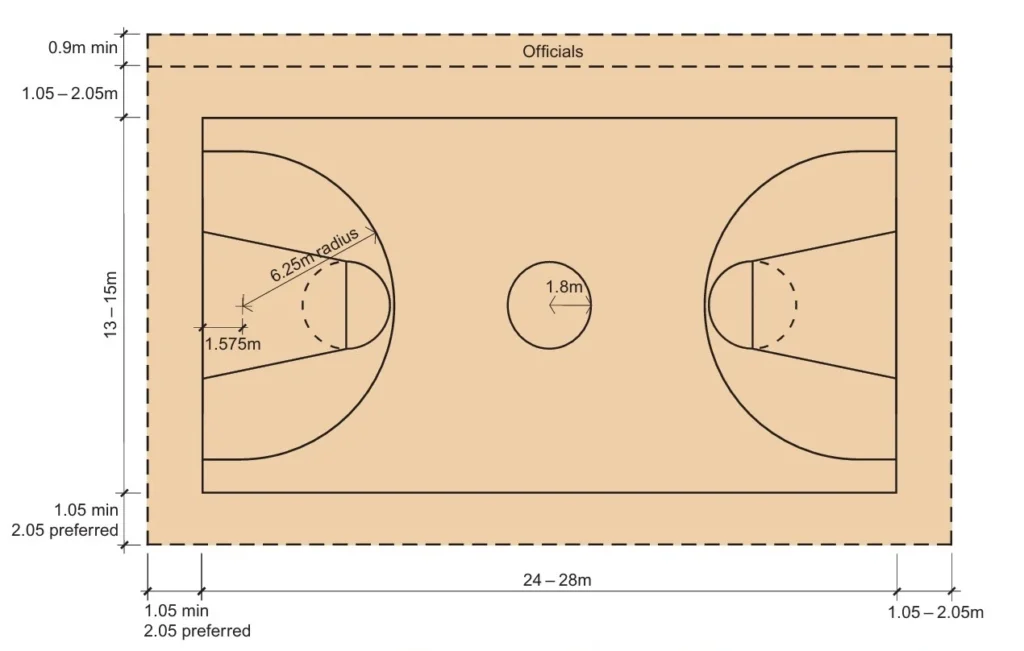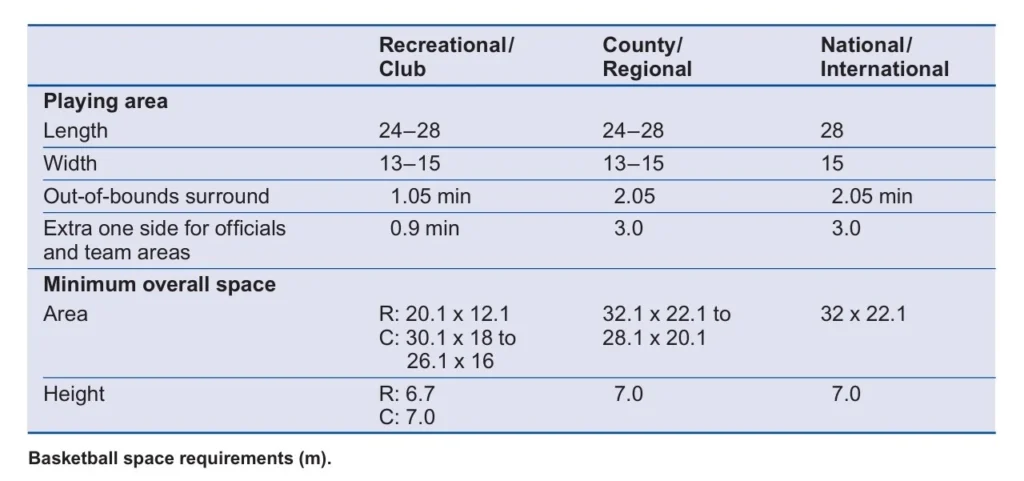Basketball court design plays a crucial role in ensuring an optimal playing experience, whether for professional games, recreational play, or backyard practice. A well-designed court enhances performance, safety, and durability, making it essential to consider factors like dimensions, materials, and layout.
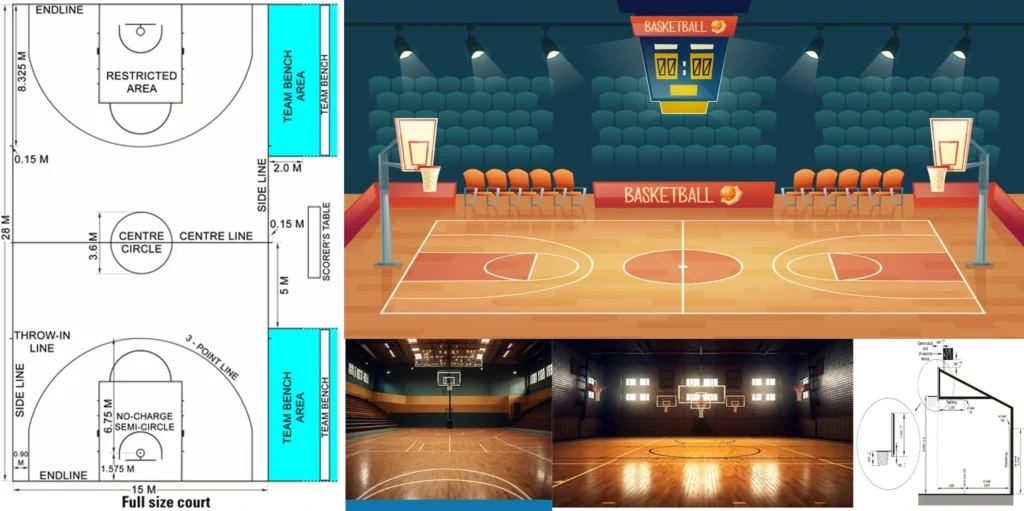
Types of Basketball Courts
Basketball courts come in various types, each serving different purposes:
- Indoor Courts – Typically found in gyms, arenas, and schools, these courts use hardwood or synthetic surfaces for professional gameplay and training.
- Outdoor Courts – Common in parks and residential areas, outdoor courts are usually made of concrete, asphalt, or modular tiles to withstand weather conditions.
- Professional Courts – NBA, FIBA, and NCAA courts follow specific dimensions, materials, and lighting standards for official competitions.
- Backyard Courts – Custom-built for home use, these courts can be full-sized or half-courts, designed based on available space and budget.
- Multi-Purpose Courts – Designed to accommodate multiple sports like basketball, volleyball, and tennis, these courts are ideal for schools and community centers.
If you want to know about the Types of slabs or Permeable concrete or Islamic architecture, please click the link.
1) Court and equipment
The Basketball competitions are divided into three (3) levels:
i) High level competitions (Level 1):
FIBA official competitions like Olympic Tournaments; World Olympic qualifying Tournaments for Men and Women, World Championships for Men, Women, U-19 and U-17; Zone Championships for Men and Women.
All equipment at these competitions must be FIBA approved Level 1 and must display the FIBA logo in the FIBA approved layout.
ii) Medium level competitions (Level 2):
All other FIBA official competitions and high-level competitions of the national federations.
iii) Other competitions (Level 3):
All other competitions not included in the above, falls under this category
Playing court
The playing court shall have a flat, hard surface free from obstructions, with dimensions of twenty-eight (28) m in length by fifteen (15) m in width measured from the inner edge of the boundary line.
Lines
All lines shall be drawn in white color, 50 mm in width and clearly visible
Boundary line
The playing court shall be limited by the boundary line, consisting of the end lines and the sidelines. These lines are not part of the playing court. Any obstruction including seated team bench personnel shall be at least 2 m from the playing court.
Centre line, centre circle and free-throw semi-circles
- The centre line shall be marked parallel to the end lines from the mid-points of the sidelines. It shall extend 0.15 m beyond each sideline. The centre line is part of the backcourt.
- The centre circle shall be marked in the centre of the playing court and have a radius of 1.80 m measured to the outer edge of the circumference. If the inside of The centre circle is painted, it must be the same color as the restricted areas.
- The free-throw semi-circles shall be marked on the playing court with a radius of 1.80 m measured to the outer edge of the circumference and with their centers at the midpoints of the free-throw lines.
Note: For more details refer FIBA Basketball Rules
- The scorer’s table, a minimum of 6,000 mm in length and 800 mm in height, must be placed on a platform of a minimum of 200 mm in height.
- All spectators must be seated at a distance of at least 5,000 mm from the outer edge of the boundary line of the playing court.
- The height of the ceiling or the lowest obstruction above the playing floor shall be a minimum of seven (7) m.
Playing floor
The playing floor surface shall be of minimum length of 32 m and a minimum width of 19 m and have an antiglare surface. It shall be made of:
- Permanent wooden flooring (Levels 1 and 2).
- Mobile wooden flooring (Levels 1 and 2).
- Permanent synthetic flooring (Levels 2 and 3).
- Mobile synthetic flooring (Levels 2 and 3).
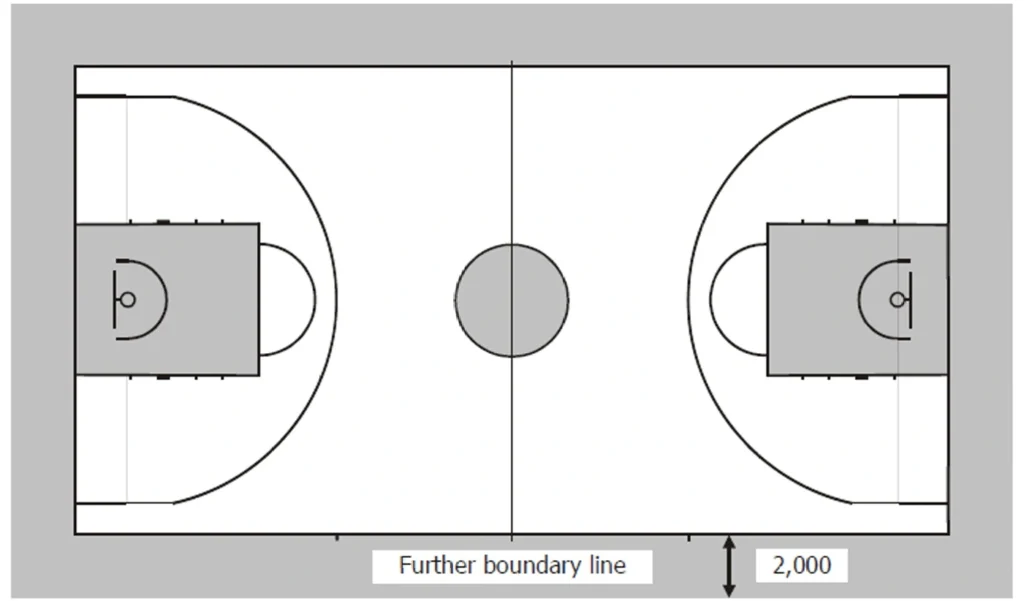
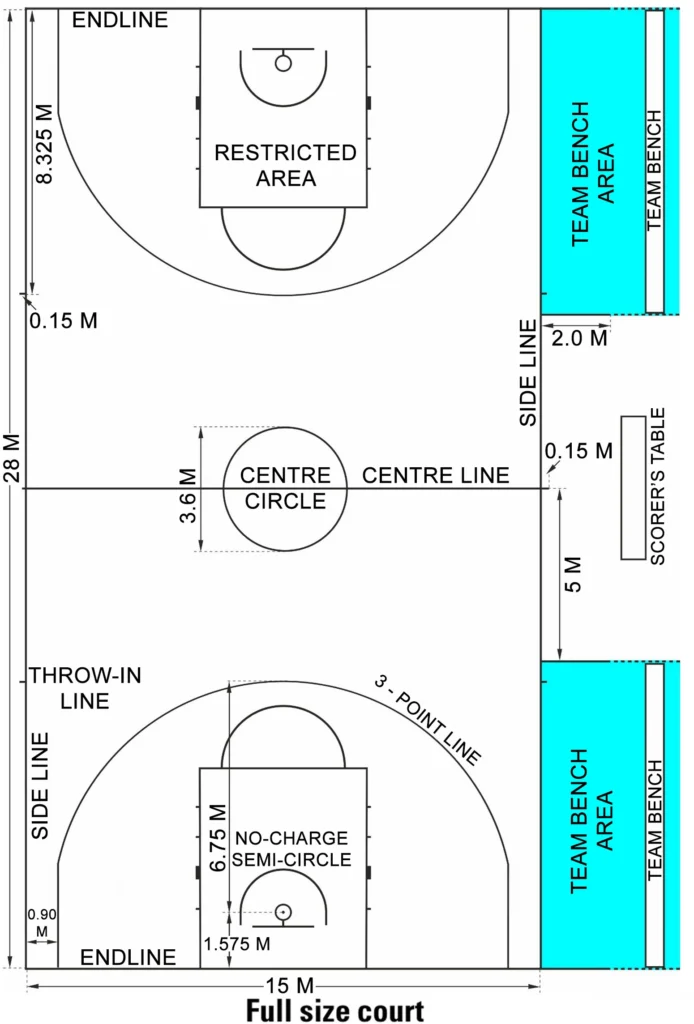
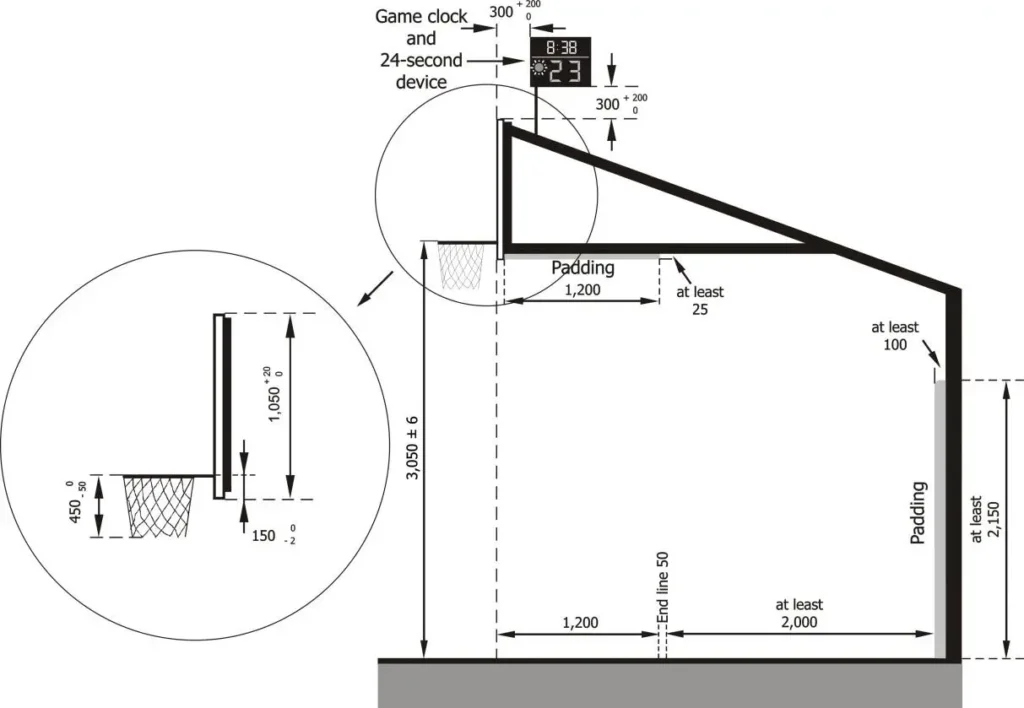
Backboard
The backboards shall be made of a suitable transparent material (for Level 1 and 2, of a tempered safety glass), made in one (1) piece, non reflective, with a flat front surface and shall have a protective framework of the backboard support structure around the outer edge. It should be manufactured such that, if broken, the pieces of glass do not split off.
For Level 3, the backboards may be made of other material(s) painted white, but must meet the other above specifications.
The backboards shall measure 1,800 mm (+ a maximum of 30 mm) horizontally and1,050 mm (+ a maximum of 20 mm) vertically.
All lines on the backboards shall be
- in white, if the backboards are transparent;
- In black, if the white painted backboards are non-transparent.
- 50 mm in width.
The borders of the backboards shall be marked with a boundary line (Diagram 2) and an additional rectangle behind the ring as follows:
- Outside dimensions: 590 mm (+ a maximum of 20 mm) horizontally and 450 mm (+ maximum of 8 mm) vertically.
- The top edge of the base of the rectangle shall be level with the top of the ring and150 mm (- 2 mm) above the bottom edge of the backboard.
For Levels 1 and 2, each backboard shall be equipped with lighting around its perimeter, mounted on the inside borders of the backboards and which lights up in red only when the game clock signal sounds for the end of a period. The lighting shall be a minimum of 10 mm in width and cover a minimum of 90 % along the edge of the backboard glass area.
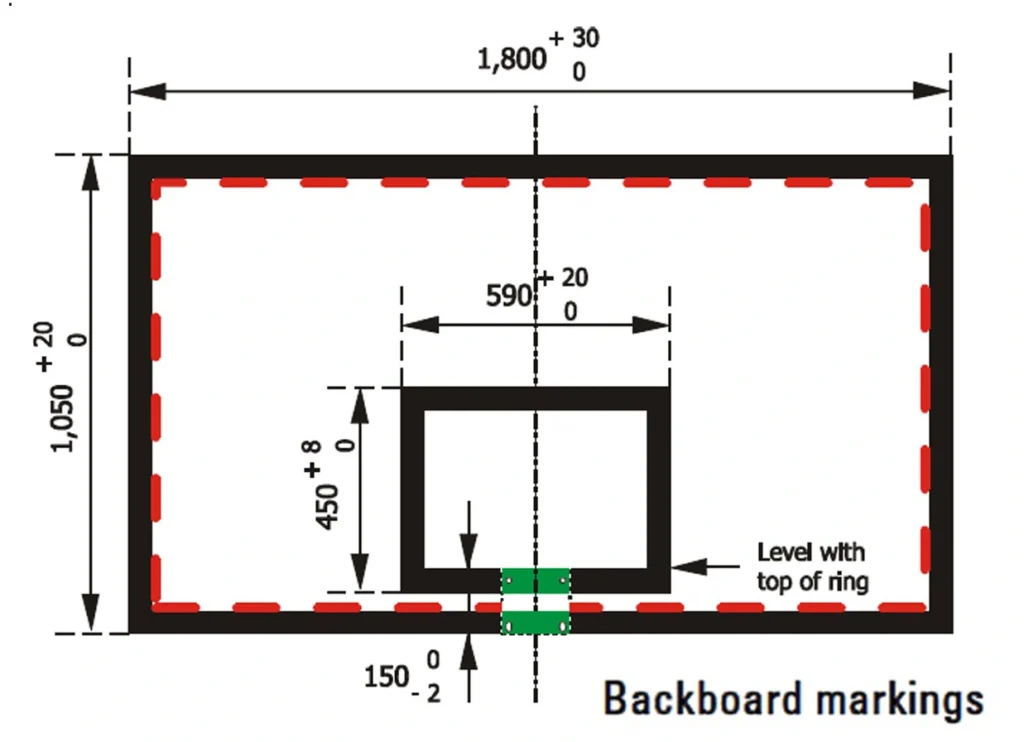
Basket ring
The rings shall be made of solid steel and shall:
Have an inside diameter of a minimum of 450 mm and a maximum of 459 mm.
Be painted orange within the following Natural Colour System (NCS) FIBA approved spectrum
Have its metal a minimum of 16 mm and a maximum of 20 mm in diameter. The net shall be attached to each ring in 12 places. The fittings for the attachment shall:
Not have any sharp edges or gaps,
Have gaps smaller than 8 mm, to prevent fingers from entering,
Not be designed as hooks for Level 1 and 2.
2) Specifications for basketball court for SAI centres
For FIBA, World and Official Competitions, only a wooden or synthetic surface is allowed.
Any surface must be previously approved by the FIBA,
Basketball is an indoor game, however it is played outdoor also, but specification of outdoor flooring surface has not been officially specified by FIBA. For outdoor surface provide Synthetic Acrylic flooring (5 to 8 layers) approved by ITF
For Indoor surfaces provide
- Maple/Teak wood Flooring with the flooring system and manufacturer approved by FIBA in SAI Centres where National camps are held or Elite trainees train
- At all other locations provided Synthetic Polyurethane flooring with flooring system and manufacturer approved by FIBA
Note: In all areas which are termite infested only Synthetic Polyurethane flooring with flooring system and manufacturer approved by FIBA shall be provided
Clear height of the Basketball Indoor hall shall be kept minimum 7 mt as specified by FIBA
Dimensions
Dimensions/Details as indicated under club/county/Regional in the figure below shall be followed by all Regional Centre /Academic Institution.
At all other locations provide dimensions/details indicated under ‘Recreational’ Dimensions/Details indicated under National/International category shall be provided only if the court is proposed to hold National/International competition with spectator facilities
